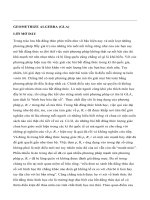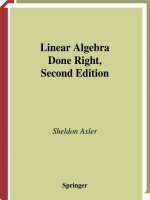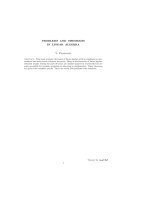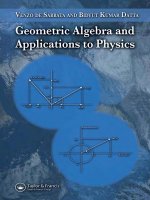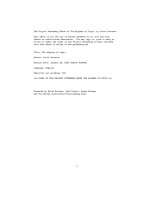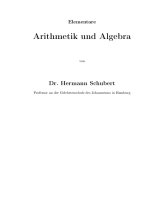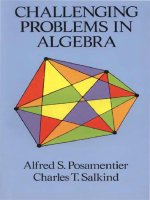dug ei algebra
Bạn đang xem bản rút gọn của tài liệu. Xem và tải ngay bản đầy đủ của tài liệu tại đây (26.03 MB, 1,104 trang )
This page intentionally left blank
Elementary
and Intermediate
Algebra
F o u r t h
e d i t i o n
Mark Dugopolski
Southeastern Louisiana University
TM
dug84356_fm.indd i
10/28/10 7:01 PM
TM
ELEMENTARY AND INTERMEDIATE ALGEBRA, FOURTH EDITION
Published by McGraw-Hill, a business unit of The McGraw-Hill Companies, Inc., 1221 Avenue of the
Americas, New York, NY 10020. Copyright © 2012 by The McGraw-Hill Companies, Inc. All rights
reserved. Previous editions © 2009, 2006, and 2002. No part of this publication may be reproduced or
distributed in any form or by any means, or stored in a database or retrieval system, without the prior
written consent of The McGraw-Hill Companies, Inc., including, but not limited to, in any network or
other electronic storage or transmission, or broadcast for distance learning.
Some ancillaries, including electronic and print components, may not be available to customers outside
the United States.
This book is printed on acid-free paper.
1 2 3 4 5 6 7 8 9 0 RJE/RJE 1 0 9 8 7 6 5 4 3 2 1
ISBN 978–0–07–338435–1
MHID 0–07–338435–6
ISBN 978–0–07–735329–2 (Annotated Instructor’s Edition)
MHID 0–07–735329–3
Vice President, Editor-in-Chief: Marty Lange
Vice President, EDP: Kimberly Meriwether David
Senior Director of Development: Kristine Tibbetts
Editorial Director: Stewart K. Mattson
Sponsoring Editor: Mary Ellen Rahn
Developmental Editor: Adam Fischer
Marketing Manager: Peter A. Vanaria
Lead Project Manager: Peggy J. Selle
Senior Buyer: Sandy Ludovissy
Senior Media Project Manager: Jodi K. Banowetz
Designer: Tara McDermott
Cover Designer: Greg Nettles/Squarecrow Design
Cover Image: © Bryan Mullennix/Alamy
Lead Photo Research Coordinator: Carrie K. Burger
Compositor: Glyph International
Typeface: 10.5/12 Times Roman
Printer: R. R. Donnelley
All credits appearing on page or at the end of the book are considered to be an extension of the
copyright page.
Photo Credits: Page 75: © Vol. 141/Corbis; p. 82: © Reuters/Corbis; p. 150 (top): © George Disario/
Corbis; p. 168: © Vol. 166/Corbis; p. 193 (bottom): © Ann M. Job/AP/Wide World Photos; p. 246
(bottom left): © Fancy Photography/Veer RF; p. 253: © Michael Keller/Corbis; p. 255: © DV169/Digital
Vision; p. 476: © Vol. 128/Corbis; p. 557: © Daniel Novisedlak/Flickr/Getty RF; p. 810: © Vol. 168/
Corbis; p. 839: © Stockdisc/Digital Vision RF. All other photos © PhotoDisc/Getty RF.
Library of Congress Cataloging-in-Publication Data
Dugopolski, Mark.
Elementary and intermediate algebra / Mark Dugopolski.—4th ed.
p. cm.
Includes index.
ISBN 978–0–07–338435–1—ISBN 0–07–338435–6 and ISBN 978–0–07–735329–2—ISBN
0–07–735329–3 (annotated instructor’s edition) (hard copy: alk. paper) 1. Algebra—Textbooks. I. Title.
QA152.3.D84 2012
512.9—dc22
2010024307
www.mhhe.com
dug84356_fm.indd ii
10/28/10 7:01 PM
About the Author
M
ark Dugopolski was born and raised in Menominee, Michigan. He received
a degree in mathematics education from Michigan State University and
then taught high school mathematics in the Chicago area. While teaching
high school, he received a master’s degree in mathematics from Northern Illinois
University. He then entered a doctoral program in mathematics at the University of
Illinois in Champaign, where he earned his doctorate in topology in 1977. He was
then appointed to the faculty at Southeastern Louisiana University, where he taught for
25 years. He is now professor emeritus of mathematics at SLU. He is a member of MAA
and AMATYC. He has written many articles and numerous mathematics textbooks.
He has a wife and two daughters. When he is not working, he enjoys gardening, hiking,
bicycling, jogging, tennis, fishing, and motorcycling.
In loving memory of my parents,
Walter and Anne Dugopolski
dug84356_fm.indd iii
10/28/10 7:01 PM
McGraw-Hill Connect Mathematics McGraw-Hill conducted in-depth research to create a new and
improved learning experience that meets the needs of today’s students and instructors. The result is a
reinvented learning experience rich in information, visually engaging, and easily accessible to both
instructors and students. McGraw-Hill’s Connect is a Web-based assignment and assessment platform
that helps students connect to their coursework and prepares them to succeed in and beyond the course.
Connect Mathematics enables math instructors to create and share courses and assignments with
colleagues and adjuncts with only a few clicks of the mouse. All exercises, learning objectives, videos,
and activities are directly tied to text-specific material.
1
You and your students want a fully integrated online homework and learning
management system all in one place.
McGraw-Hill and Blackboard Inc. Partnership
▶ McGraw-Hill has partnered with
Blackboard Inc. to offer the deepest
integration of digital content and tools
with Blackboard’s teaching and learning
platform.
▶ Life simplified. Now, all McGraw-Hill
content (text, tools, & homework) can
be accessed directly from within your
Blackboard course. All with one sign-on.
▶ Deep integration. McGraw-Hill’s contentt
and content engines are seamlessly
woven within your Blackboard course.
▶ No more manual synching! Connect assignments
ignments
within Blackboard automatically (and instantly) feed
grades directly to your Blackboard grade center.
No more keeping track of two gradebooks!
2
Your students want an assignment page that is easy to use and includes
lots of extra resources for help.
Efficient Assignment Navigation
▶ Students have access to immediate
feedback and help while working
through assignments.
▶ Students can view detailed step-by-step
solutions for each exercise.
dug84356_fm.indd iv
10/28/10 7:01 PM
Connect.
3
Learn.
Succeed.
Your students want an interactive eBook rich with integrated functionality.
Integrated Media-Rich eBook
▶ A Web-optimized eBook is seamlessly integrated within
ConnectPlus Mathematics for ease of use.
▶ Students can access videos, images, and other media in
context within each chapter or subject area to enhance
their learning experience.
▶ Students can highlight, take notes, or even access shared
instructor highlights/notes to learn the course material.
▶ The integrated eBook provides students with a cost-saving
alternative to traditional textbooks.
4
You want a more intuitive and efficient assignment creation process to
accommodate your busy schedule.
Assignment Creation Process
▶ Instructors can select textbook-specific
questions organized by chapter, section,
and objective.
▶ Drag-and-drop functionality makes
creating an assignment quick and easy.
▶ Instructors can preview their assignments
for efficient editing.
5
You want a gradebook that is easy to use and provides you with flexible reports
to see how your students are performing.
Flexible Instructor Gradebook
▶ Based on instructor feedback, Connect
Mathematics’ straightforward design
creates an intuitive, visually pleasing grade
management environment.
▶ View scored work immediately and track
individual or group performance with
various assignment and grade reports.
www.mcgrawhillconnect.com
dug84356_fm.indd v
10/28/10 7:01 PM
Preface
FROM THE AUTHOR
I
would like to thank the many students and faculty that have used my books over the
years. You have provided me with excellent feedback that has assisted me in writing a better, more student-focused book in each edition. Your comments are always
taken seriously, and I have adjusted my focus on each revision to satisfy your needs.
Understandable Explanations
I originally undertook the task of writing my own book for the elementary and
intermediate algebra course so I could explain mathematical concepts to students in
language they would understand. Most books claim to do this, but my experience
with a variety of texts had proven otherwise. What students and faculty will find in
my book are short, precise explanations of terms and concepts that are written in
understandable language. For example, when I introduce the Commutative Property
of Addition, I make the concrete analogy that “the price of a hamburger plus a Coke
is the same as the price of a Coke plus a hamburger,” a mathematical fact in their
daily lives that students can readily grasp. Math doesn’t need to remain a mystery
to students, and students reading my book will find other analogies like this one that
connect abstractions to everyday experiences.
Detailed Examples Keyed to Exercises
My experience as a teacher has taught me two things about examples: they need to
be detailed, and they need to help students do their homework. As a result, users
of my book will find abundant examples with every step carefully laid out and
explained where necessary so that students can follow along in class if the instructor is
demonstrating an example on the board. Students will also be able to read them on their
own later when they’re ready to do the exercise sets. I have also included a double
cross-referencing system between my examples and exercise sets so that, no matter
which one students start with, they’ll see the connection to the other. All examples
in this edition refer to specific exercises by ending with a phrase such as “Now do
Exercises 11–18” so that students will have the opportunity for immediate practice of
that concept. If students work an exercise and find they are stumped on how to finish
it, they’ll see that for that group of exercises they’re directed to a specific example to
follow as a model. Either way, students will find my book’s examples give them the
guidance they need to succeed in the course.
vi
dug84356_fm.indd vi
10/28/10 7:02 PM
Preface
vii
Varied Exercises and Applications
A third goal of mine in writing this book was to give students more variety in the
kinds of exercises they perform than I found in other books. Students won’t find
an intimidating page of endless drills in my book, but instead will see exercises in
manageable groups with specific goals. They will also be able to augment their math
proficiency using different formats (true/false, written response, multiple-choice)
and different methods (discussion, collaboration, calculators). Not only is there
an abundance of skill-building exercises, I have also researched a wide variety of
realistic applications using real data so that those “dreaded word problems” will
be seen as a useful and practical extension of what students have learned. Finally,
every chapter ends with critical thinking exercises that go beyond numerical computation and call on students to employ their intuitive problem-solving skills to find
the answers to mathematical puzzles in fun and innovative ways. With all of these
resources to choose from, I am sure that instructors will be comfortable adapting my
book to fit their course, and that students will appreciate having a text written for their
level and to stimulate their interest.
Listening to Student and Instructor Concerns
McGraw-Hill has given me a wonderful resource for making my textbook more
responsive to the immediate concerns of students and faculty. In addition to sending
my manuscript out for review by instructors at many different colleges, several times
a year McGraw-Hill holds symposia and focus groups with math instructors where
the emphasis is not on selling products but instead on the publisher listening to the
needs of faculty and their students. These encounters have provided me with a wealth
of ideas on how to improve my chapter organization, make the page layout of my
books more readable, and fine-tune exercises in every chapter. Consequently, students
and faculty will feel comfortable using my book because it incorporates their specific
suggestions and anticipates their needs. These events have particularly helped me in
the shaping of the fourth edition.
Improvements in the Fourth Edition
OVERALL
• All Warm-Up exercise sets have been rewritten and now include a combination
of fill-in-the-blank and true/false exercises. This was done to put a greater
emphasis on vocabulary.
• Using a graphing calculator with this text is still optional. However, more
Calculator Close-Ups and more graphing calculator required exercises have
been included throughout the text for those instructors who prefer to emphasize
graphing calculator use.
• Every chapter now includes a Mid-Chapter Quiz. This quiz can be used to assess
student progress in the chapter.
• Numerous applications have been updated and rewritten.
• All Enriching Your Mathematical Word Power exercise sets have been expanded
and rewritten as fill-in-the-blank exercises.
• All Making Connections exercise sets have been expanded so that they present a
more comprehensive cumulative review.
• Teaching Tips are now included throughout the text, along with many new
Helpful Hints.
dug84356_fm.indd vii
10/28/10 7:02 PM
viii
Preface
CHAPTER 1
• New material on equivalent fractions and reducing
fractions
• Exercise sets: 9 updated and rewritten applications
CHAPTER 2
• Functions are now introduced in the context of formulas.
• New material on the language of functions
• The language of functions and function notation are
now used more extensively throughout the text.
• New material on the simple interest formula,
perimeter, and original price applications
• New definition of a function and new caution box for
the formula and function section
• Three updated and rewritten examples to reflect
functions in the context of formulas
• Exercise sets: 10 updated and rewritten applications
• End of chapter: revised and updated summary, review
exercises, and chapter test
CHAPTER 3
• New material on graphing ordered pairs and ordered
pairs as solutions to equations
• Simplified introduction to graphing a linear equation
in two variables
• New material on graphing a line using intercepts
• Improved definitions of intercepts and slope intercept form
• New material on function notation and applications
• Two updated examples and a new caution box
• Revised and updated exercise sets for Sections 3.1,
3.3, and 3.4
• Revised and updated Math at Work feature
• Exercise sets: 5 updated and rewritten applications
• End of chapter: revised and updated review exercises
and chapter test
• Exercise sets: revised Sections 4.2 and 4.3 to reflect
new organization
• End of chapter: revised and updated review exercises
and chapter test
CHAPTER 5
• Section 5.2 has been rewritten with more emphasis on
factoring by grouping.
• Section 5.2 has been reorganized so that factoring by
grouping comes before special products.
• Section 5.5 has been simplified by eliminating
division in factoring.
• New material on factoring applications, factoring by
grouping, and the Pythagorean Theorem
• New strategy box for factoring a four-term
polynomial by grouping
• New strategy box for factoring x2 ϩ bx ϩ c by
grouping
• Three new examples and four revised examples
• Rewritten explanation on factoring ax2 ϩ bx ϩ c
with a ϭ 1
• New explanation of the sum of two squares prime
polynomial
• New strategy and explanation for factoring sum and
difference of cubes
• Revised strategy for factoring polynomials
completely
• Exercise sets: revised Sections 5.1, 5.5, and 5.6 to
reflect new organization
• End of chapter: revised and updated review
exercises
CHAPTER 6
• Updated Section 6.1 by including rational functions
• New explanation on rational functions and domain of
a rational function
CHAPTER 7
CHAPTER 4
• Section 4.2, Negative Exponents and Scientific
Notation, has been split into two sections—
Section 4.2, Negative Exponents, and Section 4.3,
Scientific Notation.
• Three revised examples and new study tips
• New material on using rules for negative exponents
• New material on scientific notation, including
“Combining Numbers and Words” and “Applications”
• New material on polynomial functions
dug84356_fm.indd viii
• Section 7.1, Solving Systems by Graphing and
Substitution, has been split into two sections—
Section 7.1, The Graphing Method, and Section 7.2,
The Substitution Method.
• Five updated examples
• New summary of the methods for solving systems of
equations
• Exercise sets: revised Sections 7.3 and 7.4
• End of chapter: revised and updated review exercises
and chapter test
10/28/10 7:02 PM
Preface
CHAPTER 9
• New material on roots and variables
• New presentation of perfect squares, cubes, and
fourth powers
• New material on radical functions and domain of
radical functions
• Four revised applications and one revised example
• Exercise sets: revised Section 9.2
• End of chapter: revised and updated review exercises
and chapter test
CHAPTER 10
• Simplified Section 10.5 to focus exclusively on
quadratic inequalities
• New definition of quadratic inequalities
• New strategies for solving a quadratic inequality
graphically and with the Test-Point Method
• Four new examples on solving quadratic inequalities
graphically and with the Test-Point Method
• The sign-graph method of solving quadratic and rational inequalities has been removed and replaced with
the more intuitive graphical method. The Test-Point
Method is also presented.
• New material on quadratic functions
• Improved figures to help clarify graphing examples
• New material using function notation with quadratics
• Exercise sets: revised Section 10.5
• End of chapter: revised and updated review exercises
and chapter test
ix
• New material on transformations of graphs, horizontal
translation, and multiple transformations
• Solving polynomial inequalities by the graphical
method and Test-Point Method has been added to
Section 11.4 after graphs of polynomial functions.
• New material and two new examples on solving
polynomial inequalities
• Solving rational inequalities by the graphical method
and Test Points has been added to Section 11.5 after
the graphs of rational functions are discussed.
• Rational inequalities have been moved to Section 11.5
where the graphs of rational functions are discussed.
• New material on rational inequalities, along with two
new examples for solving graphically and with test
points
• Exercise sets: revised Sections 11.3, 11.4 and 11.5.
• End of chapter: revised and updated summary, review
exercises, and chapter test
CHAPTER 12
• New definition of domain
• New material on exponential and logarithmic
functions
CHAPTER 13
• Simplified material on parabolas in Section 13.2
CHAPTER 14
• Two updated applications.
CHAPTER 11
• Section 11.3, Transformations of Graphs, has been
rearranged in a more natural order.
dug84356_fm.indd ix
10/28/10 7:02 PM
x
Preface
Manuscript Review Panels
Teachers and academics from across the country reviewed the various drafts of the manuscript to give feedback on
content, design, pedagogy, and organization. This feedback was summarized by the book team and used to guide the
direction of the text. I would like to thank the following professors for their participation in making this fourth edition.
Seth Daugherty, Saint Louis CC–Forest Park
Shing So, University of Central Missouri
Elsie Newman, Owens Community College
Patrick Ward, Illinois Central College
Kenneth Thompson, East Central
Community College
Joseph Sedlacek, Kirkwood Community
College
Jinhua Tao, University of Central Missouri
Rajalakshmi Baradwaj, University of
Maryland–Baltimore County
Jinfeng Wei, Maryville University
Sean Stewart, Owens Community College
Mildred Vernia, Indiana University–
Southeast
Sharon Robertson, University of
Tennessee–Martin
Manuel Sanders, University of South
Carolina
Randall Castleton, University of
Tennessee–Martin
Randell Simpson, Temple College
Jan Butler, CCC Online
Debra Pharo, Northwestern Michigan
College
Paul Jones, University of Cincinnati
David Ray, University of Tennessee–
Martin
Dale Vanderwilt, Dordt College
Lori Wall, University of England–Biddeford
Hossein Behforooz, Utica College
Joan Brown, Eastern New Mexico
University
Roland Trevino, San Antonio College
Carmen Buhler, Minneapolis Community
and Tech College
Irma Bakenhus, San Antonio College
Mary Peddycoart, Kingwood College
Kimberly Caldwell, Volunteer State
Community College
Larry Green, Lake Tahoe Community
College
Tim McBride, Spartanburg Technical
College
Wendy Conway, Oakland Community
College–Highland Lakes
Pinder Naidu, Kennesaw State University
Glenn Robert Jablonski, Triton College
Robert Diaz, Fullerton College
Fereja Tahir, Illinois Central College
Derek Martinez, Central New Mexico
Community College
David French, Tidewater Community
College
Dennis Reissig, Suffolk County
Community College
Teresa Houston, East Mississippi
Community College–Scooba
Charles Patterson, Louisiana Tech University
Carla Monticelli, Camden County College
Rhoderick Fleming, Wake Technical
Community College
Madhu Motha, Butler County Community
College
Toni McCall, Angelina College
Chris Reisch, Jamestown Community
College
Brooke Lee, San Antonio College
Timothy McKenna, University of
Michigan–Dearborn
Jean Peterson, University of Wisconsin–
Oshkosh
Amy Young, Navarro College
Jenell Sargent, Tennessee State University
Mark Brenneman, Mesa Community College
Litsa St Amand, Mesa Community College
Jeff Igo, University of Michigan–Dearborn
Suzanne Doviak, Old Dominican University
Judith Atkinson, University of Alaska–
Fairbanks
Jill Rafael, Sierra College
Dan Rothe, Alpena Community College
Richard Rupp, Del Mar College
Gerald Busald, San Antonio College
Stephen Drake, Northwestern Michigan
College
Bobbie Jo Hill, Coastal Bend College
Michael Price, University of Oregon
John Squires, Chattanooga State Tech
Mary Kay Best, Coastal Bend College
Donald Munsey, Louisiana Delta
Community College
Jane Thompson, Waubonsee Community
College
Peggy Blanton, Isothermal Community
College
Richard Watkins, Tidewater Community
College
Mary Frey, Cincinnati State Tech and
Community College
Kristina Sampson, Lone Star College
Kimberly Bonacci, Indiana University–
Paul Diehl, Indiana University Southeast
Southeast
Jackie Wing, Angelina College
I also want to express my sincere appreciation to my wife, Cheryl, for her invaluable patience and support.
Mark Dugopolski
Ponchatoula, Louisiana
dug84356_fm.indd x
10/28/10 7:02 PM
Guided
Tour
Features and Supplements
“I was ‘gripped’ by the
examples and introductions
to the topics. These were
interesting, current, and
nicely written. Students will
find these motivating to learn
the material.“
Timothy McKenna,
University of Michigan–Dearborn
Chapter Opener
Each chapter opener features a
real-world situation that can be
modeled using mathematics. The
application then refers students
to a specific exercise in the
chapter’s exercise sets.
xi
dug84356_fm.indd xi
10/28/10 7:02 PM
xii
Guided
Tour
Features and Supplements
In This Section
The In This Section listing gives
a preview of the topics to be
covered in the section. These
subsections have now been
numbered for easier reference.
In addition, these subsections
are listed in the relevant places in
the end-of-section exercises.
Examples
Examples refer directly to
exercises, and those exercises
in turn refer back to that
example. This double
cross-referencing helps
students connect examples to
exercises no matter which one
they start with.
“I really appreciate how the examples correlate with the
homework sections. These specific examples are helpful to
students that go onto college algebra and pre-calc math
classes.“
Sean Stewart, Owens Community College
“The worked out examples are clearly explained, no step
is left out, and they progress in a fashion that eases the
student from very basic to the somewhat complex.“
Larry Green, Lake Tahoe Community College
dug84356_fm.indd xii
10/28/10 7:02 PM
Guided
Math at Work
Math at Work
Tour
xiii
Features and Supplements
Kayak Design
The Math at Work feature
appears in each chapter to
reinforce the book’s theme
of real applications
in the everyday world of work.
Kayaks have been built by the Aleut and Inuit people for the past 4000 years.
Today’s builders have access to materials and techniques unavailable to the original kayak builders. Modern kayakers incorporate hydrodynamics and materials
technology to create designs that are efficient and stable. Builders measure how
well their designs work by calculating indicators such as prismatic coefficient,
block coefficient, and the midship area coefficient, to name a few.
Even the fitting of a kayak to the paddler is done scientifically. For example,
the formula
PL ϭ 2 и BL ϩ BS 0.38 и EE ϩ 1.2
“Dugopolski uses language
and context appropriate for
the level of student for whom
the text is written without
sacrificing mathematical rigor
or precision.“
Irma Bakenhus,
San Antonio College
Ί
BW SW
ᎏᎏ Ϫ ᎏᎏ
2
2
2
ϩ (SL)2
can be used to calculate the appropriate paddle length. BL is the length of the paddle’s blade. BS is a boating style factor, which is 1.2 for touring, 1.0 for river running, and 0.95 for play boating. EE is the elbow to elbow distance with the
paddler’s arms straight out to the sides. BW is the boat width and SW is the shoulder width. SL is the spine length, which is the distance measured in a sitting position from the chair seat to the top of the paddler’s shoulder. All lengths are in
centimeters.
The degree of control a kayaker exerts over the kayak depends largely on the body contact with it. A kayaker wears the kayak. So the choice of a kayak should hinge first on the
right body fit and comfort and second on the skill level or intended paddling style. So designing, building, and even fitting a kayak is a blend of art and science.
Strategy Boxes
The strategy boxes provide a
handy reference for students
to use when they review key
concepts and techniques to
prepare for tests and homework.
They are now directly referenced
in the end-of-section exercises
where appropriate.
Margin Notes
Margin notes include Helpful Hints, which give advice on the topic they’re adjacent to;
Calculator Close-Ups, which provide advice on using calculators to verify students’ work;
and Teaching Tips, which are especially helpful in programs with new instructors who are
looking for alternate ways to explain and reinforce material.
U Helpful Hint V
U Teaching Tip V
Some students grow up believing
that the only way to solve an equation is to “do the same thing to each
side.” Then along come quadratic
equations and the zero factor property. For a quadratic equation, we
write an equivalent compound equation that is not obtained by “doing
the same thing to each side.”
Show students how to make up a
problem like this example: If x ϭ 5,
then (5 Ϫ 2)(5 ϩ 7) ϭ 36. So one of
the solutions to (x Ϫ 2)(x ϩ 7) ϭ 36
is 5. Now solve it to find both
solutions.
dug84356_fm.indd xiii
U Calculator Close-Up V
Your calculator can add signed numbers. Most calculators have a key for
subtraction and a different key for the
negative sign.
You should do the exercises in this
section by hand and then check with
a calculator.
10/28/10 7:02 PM
xiv
Guided
Tour
Features and Supplements
Exercises
Section exercises are preceded
by true/false Warm-Ups, which
can be used as quizzes or for
class discussion.
Getting More Involved
concludes the exercise set
with Discussion, Writing,
Exploration, and Cooperative
Learning activities for wellrounded practice in the skills
for that section.
Calculator Exercises
Optional calculator exercises
provide students with the
opportunity to use scientific or
graphing calculators to solve
various problems.
Video Exercises
A video icon indicates an
exercise that has a video walking
through how to solve it.
Mid-Chapter Quiz
Mid-Chapter Quizzes give
students an earlier chance check
their progress through the
chapter allowing them to identify
what past skills they need to
practice as they move forward in
their class.
dug84356_fm.indd xiv
“This text is very well written with good, detailed examples. It offers plenty of practice
exercises in each section including several real world applications.“
Randall Casleton, University of Tennessee–Martin
10/28/10 7:02 PM
Wrap-Up
The extensive and varied review
in the chapter Wrap-Up will help
students prepare for tests. First
comes the Summary with key
terms and concepts illustrated
by examples; then Enriching
Your Mathematical Word Power
enables students to test their
recall of new terminology in a
fill-in-the-blank format.
Chapter
Guided
5
Tour
xv
Features and Supplements
Wrap-Up
Summary
Factoring
Examples
Prime number
A positive integer larger than 1 that has no
integral factors other than 1 and itself
2, 3, 5, 7, 11
Prime polynomial
A polynomial that cannot be factored is prime.
x 2 ϩ 3 and x 2 Ϫ x ϩ 5 are prime.
Next come Review Exercises,
which are first linked back to the
section of the chapter that they
review, and then the exercises
are mixed without section
references in the Miscellaneous
section.
dug84356_fm.indd xv
10/28/10 7:02 PM
xvi
Guided
Tour
Features and Supplements
Chapter Test
The test gives students
additional practice to make
sure they’re ready for the real
thing, with all answers provided
at the back of the book and
all solutions available in the
Student’s Solutions Manual.
The Making Connections
feature following the Chapter
Test is a cumulative review of all
chapters up to and including the
one just finished, helping to tie
the course concepts together for
students on a regular basis.
Critical Thinking
The Critical Thinking section
that concludes every chapter
encourages students to think
creatively to solve unique and
intriguing problems and puzzles.
“The critical thinking
exercises at the end of the
chapter are a good way
to help students learn to
work in groups and to write
mathematically. Having
to explain how and why
you worked out a solution
reinforces the thinking and
writing skills necessary to be
successful in today’s world.“
Mark Brenneman,
Mesa Community College
dug84356_fm.indd xvi
10/28/10 7:02 PM
Guided
Tour
xvii
Features and Supplements
SUPPLEMENTS
Multimedia Supplements
MCGRAW-HILL HIGHER EDUCATION AND BLACKBOARD HAVE
TEAMED UP.
Blackboard, the Web-based course-management system, has partnered with McGraw-Hill to
better allow students and faculty to use online materials and activities to complement face-toface teaching. Blackboard features exciting social learning and teaching tools that foster more
logical, visually impactful and active learning opportunities for students. You’ll transform your
closed-door classrooms into communities where students remain connected to their educational
experience 24 hours a day.
This partnership allows you and your students access to McGraw-Hill’s Connect™ and
Create™ right from within your Blackboard course—all with one single sign-on.
Not only do you get single sign-on with Connect™ and Create™, you also get deep integration
of McGraw-Hill content and content engines right in Blackboard. Whether you’re choosing a
book for your course or building Connect™ assignments, all the tools you need are right where
you want them—inside of Blackboard.
Gradebooks are now seamless. When a student completes an integrated Connect™ assignment,
the grade for that assignment automatically (and instantly) feeds your Blackboard grade center.
McGraw-Hill and Blackboard can now offer you easy access to industry leading technology
and content, whether your campus hosts it, or we do. Be sure to ask your local McGraw-Hill
representative for details.
www.mcgrawhillconnect.com
McGraw-Hill conducted in-depth research to create a new and improved learning
experience that meets the needs of today’s students and instructors. The result is a
reinvented learning experience rich in information, visually engaging, and easily
accessible to both instructors and students.
McGraw-Hill’s Connect is a Web-based assignment and assessment platform
that helps students connect to their coursework and prepares them to succeed in and
beyond the course. Connect Mathematics enables math instructors to create and share
courses and assignments with colleagues and adjuncts with only a few clicks of the
mouse. All exercises, learning objectives, videos, and activities are directly tied to
text-specific material.
• Students have access to immediate feedback and help while working through
assignments.
dug84356_fm.indd xvii
10/28/10 7:02 PM
xviii
Guided
Tour
Features and Supplements
• A Web-optimized eBook is seamlessly integrated within ConnectPlus
Mathematics.
• Instructors can select textbook-specific questions organized by chapter, section,
and objective.
• Connect Mathematics’ straightforward design creates and intuitive, visually pleasing grade management environment.
Instructors: To access Connect, request registration information from your McGraw-Hill
sales representative.
Computerized Test Bank (CTB) Online (Instructors Only)
Available through Connect, this computerized test bank, utilizing Wimba Diploma®
algorithm-based testing software, enables users to create customized exams quickly.
This user-friendly program enables instructors to search for questions by topic, format, or difficulty level; to edit existing questions or to add new ones; and to scramble
questions and answer keys for multiple versions of the same test. Hundreds of textspecific open-ended and multiple-choice questions are included in the question bank.
Sample chapter tests in Microsoft Word® and PDF formats are also provided.
Online Instructor’s Solutions Manual (Instructors Only)
Available on Connect, the Instructor’s Solutions Manual provides comprehensive,
worked-out solutions to all exercises in the text. The methods used to solve the
problems in the manual are the same as those used to solve the examples in the
textbook.
Video Lectures Available Online
In the videos, qualified teachers work through selected exercises from the textbook,
following the solution methodology employed in the text. The video series is available
online as an assignable element of Connect. The videos are closed-captioned for the
hearing impaired, are subtitled in Spanish, and meet the Americans with Disabilities
Act Standards for Accessible Design. Instructors may use them as resources in a learning center, for online courses, and/or to provide extra help for students who require
extra practice.
dug84356_fm.indd xviii
10/28/10 7:02 PM
Guided
Tour
xix
Features and Supplements
www.ALEKS.com
ALEKS (Assessment and LEarning in Knowledge Spaces) is a dynamic online
learning system for mathematics education, available over the Web 24/7. ALEKS
assesses students, accurately determines their knowledge, and then guides them to
the material that they are most ready to learn. With a variety of reports, Textbook
Integration Plus, quizzes, and homework assignment capabilities, ALEKS offers
flexibility and ease of use for instructors.
• ALEKS uses artificial intelligence to determine exactly what each student knows
and is ready to learn. ALEKS remediates student gaps and provides highly
efficient learning and improved learning outcomes.
• ALEKS is a comprehensive curriculum that aligns with syllabi or specified
textbooks. Used in conjunction with a McGraw-Hill text, students also receive
links to text-specific videos, multimedia tutorials, and textbook pages.
• Textbook Integration Plus enables ALEKS to be automatically aligned with
syllabi or specified McGraw-Hill textbooks with instructor-chosen dates, chapter
goals, homework, and quizzes.
• ALEKS with AI-2 gives instructors increased control over the scope and
sequence of student learning. Students using ALEKS demonstrate a steadily
increasing mastery of the content of the course.
• ALEKS offers a dynamic classroom management system that enables instructors
to monitor and direct student progress toward mastery of course objectives.
See: www.aleks.com
Printed Supplements
Annotated Instructor’s Edition (Instructors Only)
This ancillary contains answers to all exercises in the text. These answers are printed
in a special color for ease of use by the instructor and are located on the appropriate
pages throughout the text.
Student’s Solutions Manual
The Student’s Solutions Manual provides comprehensive, worked-out solutions to all
of the odd-numbered section exercises and all exercises in the Mid-Chapter Quizzes,
Chapter Tests, and Making Connections. The steps shown in the solutions match the
style of solved examples in the textbook.
dug84356_fm.indd xix
10/28/10 7:03 PM
Contents
Applications Index
C h a p t e r
1
C h a p t e r
2
Real Numbers and Their Properties
1.1
1.2
1.3
1.4
1.5
1.6
1.7
1.8
2.2
2.3
2.4
2.5
2.6
1
The Real Numbers 2
Fractions 13
Addition and Subtraction of Real Numbers 26
Multiplication and Division of Real Numbers 34
Mid-Chapter Quiz 40
Exponential Expressions and the Order of Operations 40
Algebraic Expressions 49
Properties of the Real Numbers 58
Using the Properties to Simplify Expressions 66
Chapter 1 Wrap-Up 76
• Summary 76
• Enriching Your Mathematical Word Power 78
• Review Exercises 79
• Chapter 1 Test 82
• Critical Thinking 84
Linear Equations and Inequalities
in One Variable
2.1
xxvi
85
The Addition and Multiplication Properties
of Equality 86
Solving General Linear Equations 94
More Equations 102
Formulas and Functions 110
Mid-Chapter Quiz 120
Translating Verbal Expressions into Algebraic Expressions 120
Number, Geometric, and Uniform Motion Applications 130
xx
dug84356_fm.indd xx
11/2/10 4:59 PM
Contents
2.7
2.8
2.9
C h a p t e r
3
C h a p t e r
4
dug84356_fm.indd xxi
Discount, Investment, and Mixture Applications 137
Inequalities 144
Solving Inequalities and Applications 151
Chapter 2 Wrap-Up 160
• Summary 160
• Enriching Your Mathematical Word Power 161
• Review Exercises 161
• Chapter 2 Test 166
• Making Connections: A Review of Chapters 1–2 167
• Critical Thinking 168
Linear Equations in Two Variables
and Their Graphs
3.1
3.2
3.3
3.4
3.5
3.6
4.5
4.6
4.7
4.8
169
Graphing Lines in the Coordinate Plane 170
Slope 185
Equations of Lines in Slope-Intercept Form 199
Mid-Chapter Quiz 210
The Point-Slope Form 211
Variation 223
Graphing Linear Inequalities in Two Variables 231
Chapter 3 Wrap-Up 242
• Summary 242
• Enriching Your Mathematical Word Power 243
• Review Exercises 244
• Chapter 3 Test 248
• Making Connections: A Review of Chapters 1–3 251
• Critical Thinking 253
Exponents and Polynomials
4.1
4.2
4.3
4.4
xxi
255
The Rules of Exponents 256
Negative Exponents 264
Scientific Notation 273
Addition and Subtraction of Polynomials 279
Mid-Chapter Quiz 288
Multiplication of Polynomials 288
Multiplication of Binomials 294
Special Products 299
Division of Polynomials 305
Chapter 4 Wrap-Up 312
• Summary 312
• Enriching Your Mathematical Word Power 314
• Review Exercises 314
• Chapter 4 Test 318
• Making Connections: A Review of Chapters 1–4 319
• Critical Thinking 320
10/28/10 7:03 PM
xxii
C h a p t e r
5
C h a p t e r
6
C h a p t e r
7
dug84356_fm.indd xxii
Contents
Factoring
5.1
5.2
5.3
5.4
5.5
5.6
Factoring Out Common Factors 322
Special Products and Grouping 330
Factoring the Trinomial ax2 + bx + c with a = 1 339
Mid-Chapter Quiz 347
Factoring the Trinomial ax2 + bx + c with a ≠ 1 347
Difference and Sum of Cubes and a Strategy 355
Solving Quadratic Equations by Factoring 361
Chapter 5 Wrap-Up 372
• Summary 372
• Enriching Your Mathematical Word Power 373
• Review Exercises 374
• Chapter 5 Test 376
• Making Connections: A Review of Chapters 1–5 377
• Critical Thinking 379
Rational Expressions
6.1
6.2
6.3
6.4
6.5
6.6
6.7
6.8
7.3
7.4
381
Reducing Rational Expressions 382
Multiplication and Division 392
Finding the Least Common Denominator 400
Addition and Subtraction 407
Mid-Chapter Quiz 417
Complex Fractions 417
Solving Equations with Rational Expressions 424
Applications of Ratios and Proportions 429
Applications of Rational Expressions 438
Chapter 6 Wrap-Up 447
• Summary 447
• Enriching Your Mathematical Word Power 448
• Review Exercises 449
• Chapter 6 Test 452
• Making Connections: A Review of Chapters 1–6 453
• Critical Thinking 455
Systems of Linear Equations
7.1
7.2
321
457
The Graphing Method 458
The Substitution Method 467
Mid-Chapter Quiz 476
The Addition Method 477
Systems of Linear Equations in Three Variables 487
Chapter 7 Wrap-Up 497
• Summary 497
• Enriching Your Mathematical Word Power 497
• Review Exercises 498
• Chapter 7 Test 503
• Making Connections: A Review of Chapters 1–7 504
• Critical Thinking 506
10/28/10 7:03 PM
Contents
C h a p t e r
8
C h a p t e r
9
C h a p t e r
10
dug84356_fm.indd xxiii
More on Inequalities
8.1
8.2
8.3
8.4
9.4
9.5
9.6
10.4
10.5
557
Radicals 558
Rational Exponents 568
Adding, Subtracting, and Multiplying Radicals 579
Mid-Chapter Quiz 586
Quotients, Powers, and Rationalizing Denominators 586
Solving Equations with Radicals and Exponents 596
Complex Numbers 607
Chapter 9 Wrap-Up 616
• Summary 616
• Enriching Your Mathematical Word Power 618
• Review Exercises 618
• Chapter 9 Test 623
• Making Connections: A Review of Chapters 1–9 624
• Critical Thinking 626
Quadratic Equations, Functions, and Inequalities
10.1
10.2
10.3
507
Compound Inequalities in One Variable 508
Absolute Value Equations and Inequalities 519
Mid-Chapter Quiz 528
Compound Inequalities in Two Variables 528
Linear Programming 540
Chapter 8 Wrap-Up 547
• Summary 547
• Enriching Your Mathematical Word Power 548
• Review Exercises 548
• Chapter 8 Test 552
• Making Connections: A Review of Chapters 1–8 553
• Critical Thinking 555
Radicals and Rational Exponents
9.1
9.2
9.3
xxiii
627
Factoring and Completing the Square 628
The Quadratic Formula 639
More on Quadratic Equations 649
Mid-Chapter Quiz 658
Graphing Quadratic Functions 658
Quadratic Inequalities 668
Chapter 10 Wrap-Up 678
• Summary 678
• Enriching Your Mathematical Word Power 679
• Review Exercises 680
• Chapter 10 Test 684
• Making Connections: A Review of Chapters 1–10 685
• Critical Thinking 687
10/28/10 7:03 PM
